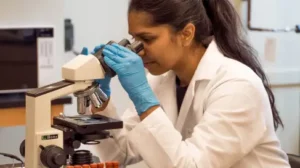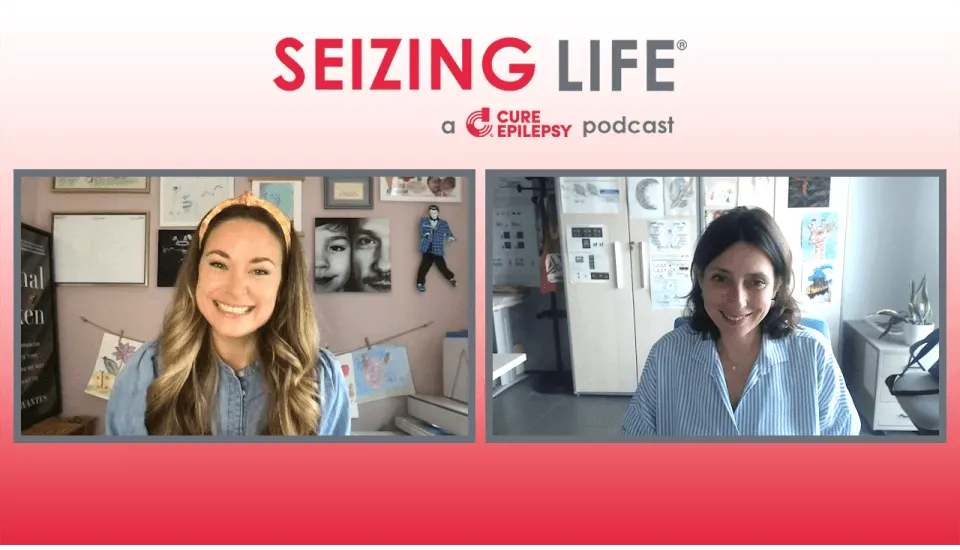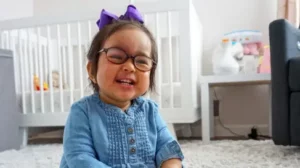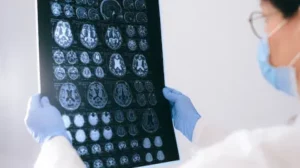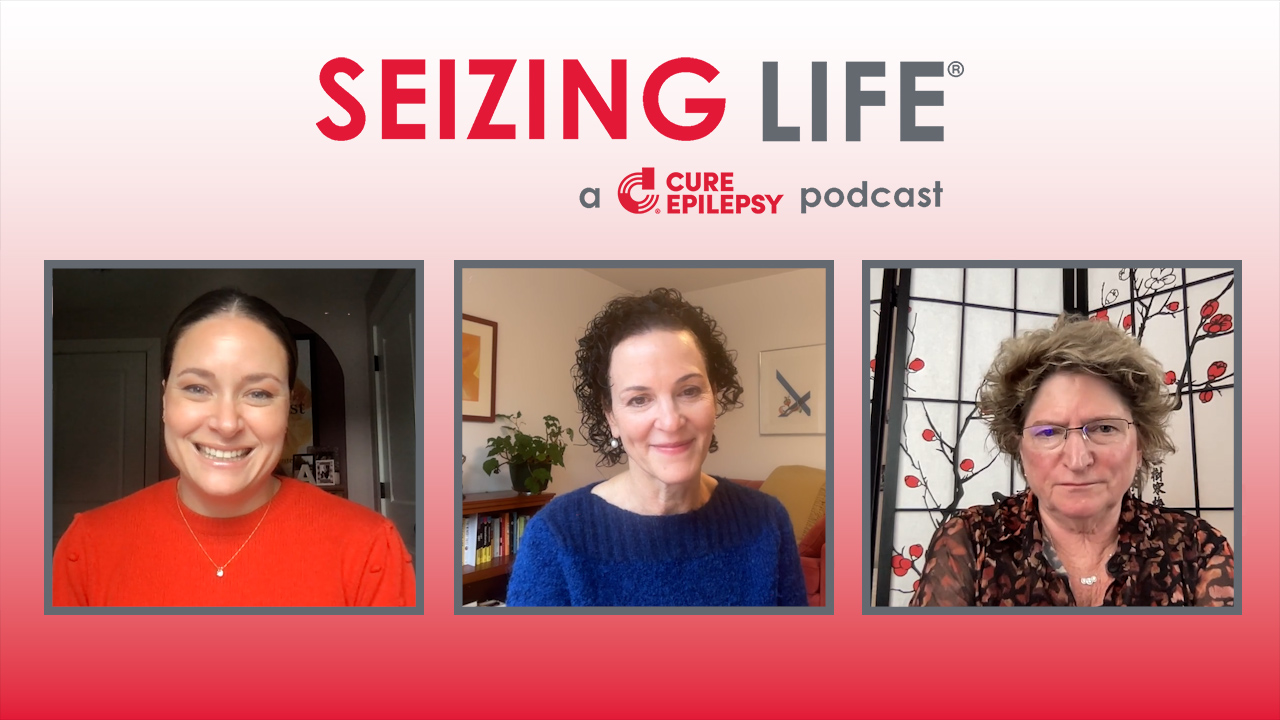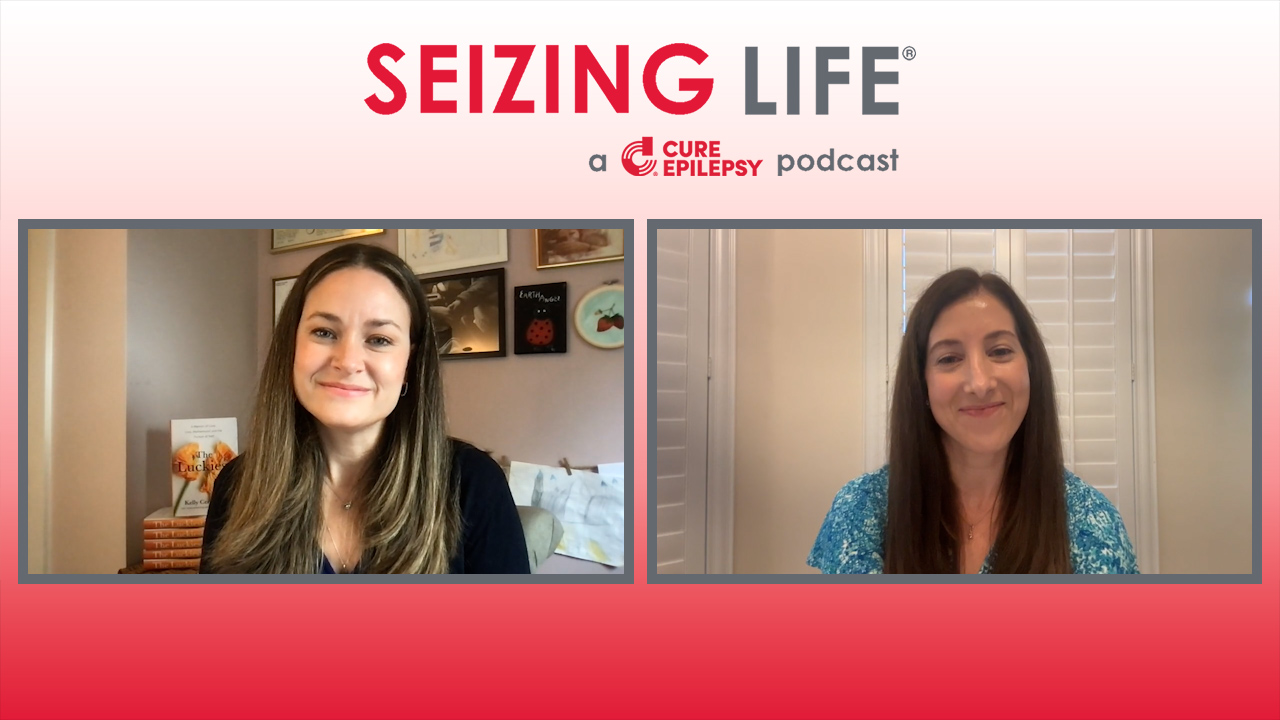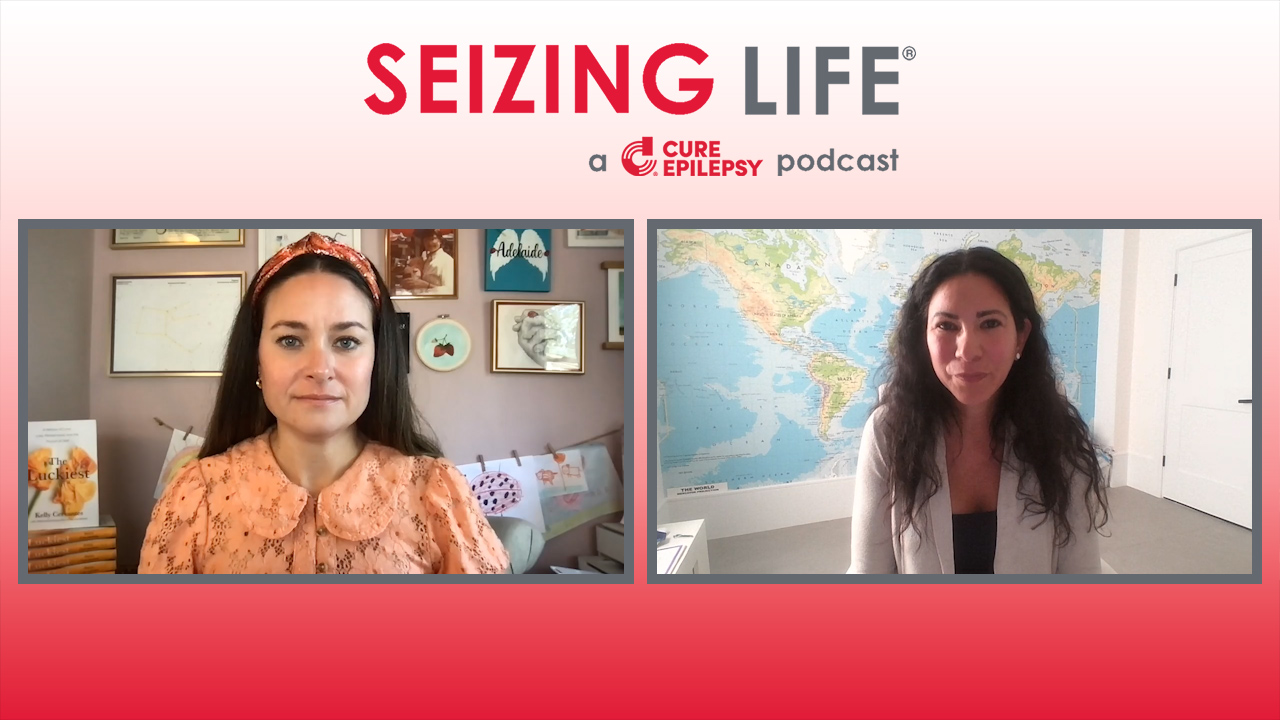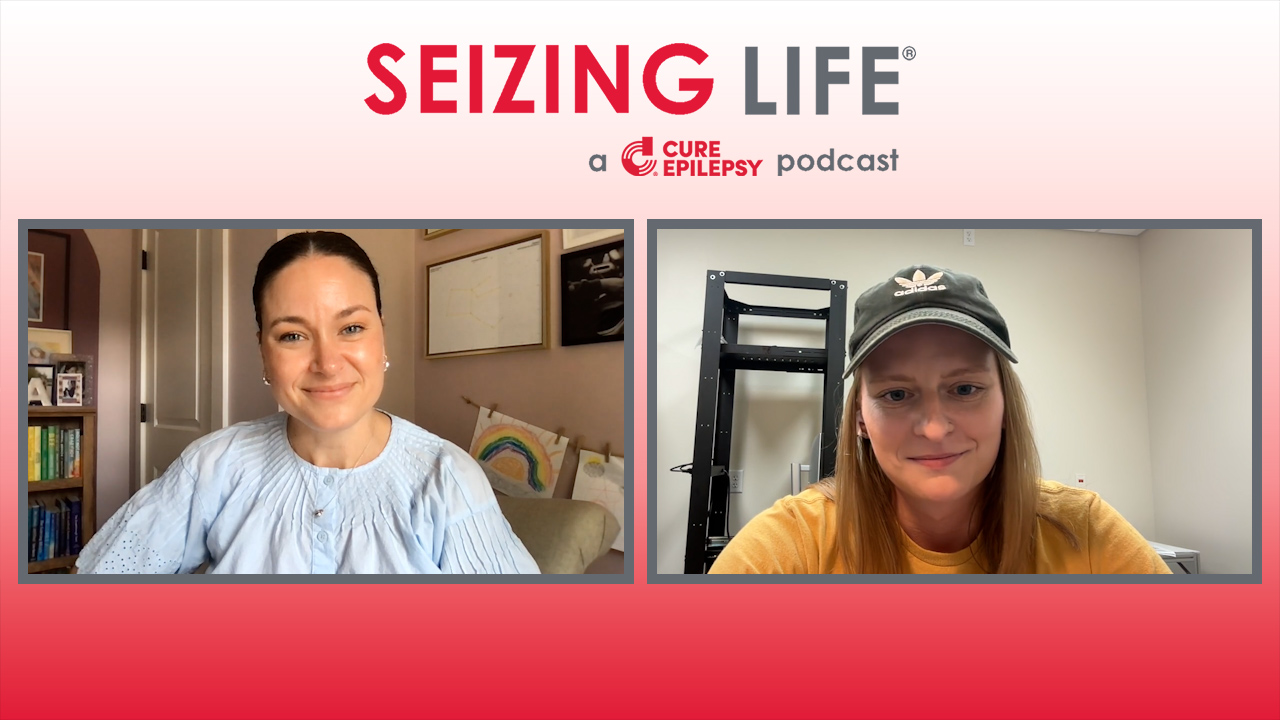Episode Overview
For many people living with epilepsy, seizures are just one of the challenges. Often an epilepsy diagnosis comes with other medical issues. While rare, one such condition can be Sturge-Weber, a vascular disorder in which blood vessels in the brain form abnormally, resulting in a facial birthmark (referred to as a port-wine stain), eye abnormalities such as glaucoma, and often seizures. As with epilepsy, the specific symptoms and impacts of Sturge-Weber can vary greatly from person to person.
Episode Transcript
Kelly Cervantes: Hi, I’m Kelly Cervantes, and this is Seizing Life, a biweekly podcast produced by CURE Epilepsy. Today, I’m delighted to welcome Cindy and Elvin Angulo to the podcast. Cindy and Elvin’s three-year-old daughter Vera was born with Sturge-Weber syndrome, a rare neurological disease, which has caused Vera to experience seizures for most of her young life. Cindy and Elvin have been public with their family’s challenges, and in doing so have raised awareness around Sturge-Weber and epilepsy. They’re here today to discuss their journey with Vera and the connection between epilepsy and Sturge-Weber syndrome. Cindy, Elvin, thank you so much for joining us today.
Elvin Angulo: Hi, thanks for having us.
Cindy Angulo: Hi, thanks for having us.
Kelly Cervantes: So, Vera has Sturge-Weber syndrome. Tell us what that is and what it entails.
Elvin Angulo: Yeah, absolutely. So Sturge-Weber syndrome is a malformation of blood vessels that appear in the face and your eyes and your brain. Basically when Vera was born, her blood vessels didn’t form properly and they formed on her face, so it actually created a birthmark on the right side of her face. Also, the blood vessels also wrapped around her eye, which caused glaucoma, so she deals with that. And then it also wrapped around different parts of her brain, which causes a slew of different [inaudible 00:01:35] from muscle weakness to epilepsy.
Kelly Cervantes: So, epilepsy is often a comorbidity of other syndromes, diseases, in fact, it’s always the symptom of something else. So, Vera has epilepsy and Sturge-Weber, which was she diagnosed with first, how did you come to these diagnoses, chicken or the egg?
Cindy Angulo: So, she was first diagnosed with Sturge-Weber syndrome at birth pretty much. We saw the port wine stain as soon as she was born and her right eye was blue. So after that, we took her to a pediatric ophthalmologist who confirmed the glaucoma. And at that point, when you have the port wine stain and the glaucoma, it’s considered Sturge-Weber syndrome. We also took her to CHOP in Philadelphia, where they confirmed … There was a neurologist who ordered an MRI and that confirmed the brain injury. So, a neurologist would consider it Sturge-Weber syndrome once you have all three components, whereas an ophthalmologist would consider just the glaucoma and the port wine stain.
Cindy Angulo: So, the MRI did show a brain injury and the occipital lobe, and we were kind of alerted that she might have seizures, but nothing was confirmed because it various so much with every child. So, some kids never have a seizure in their life with having Sturge-Weber syndrome and it’s really hard to place when it will happen or what it will look like. So, we just knew that it might happen, but we didn’t know when.
Kelly Cervantes: And so, when did it unfortunately happen?
Elvin Angulo: So, it unfortunately happened at three months old. I was actually on my parental leave at the time and Cindy was just transitioning back to work and on, I think it was the second day, I started noticing her eyes switching, rapidly moving back and forth, and then her wrist, as well as her foot were also twitching. So, I called Cindy immediately and just told her what I was seeing. I sent her a video. She recommended to immediately sent it to her sister, my sister-in-law, because she’s a pediatrician. So, we sent it to her and she basically told us that she thinks that seizures, but we should definitely contact our neurologist.
Elvin Angulo: So, we reached out to our neurologist at the time and he immediately told us to take her to the ER. So, we took her to the ER and we were there for six days and immediately upon diagnosis, she was diagnosed with epilepsy.
Cindy Angulo: Yeah, my gosh, that was January 24th, 2019. I remember the date. I mean, you never really forget those really impactful moments, but it was so casual the way that the neurologist, she called us to our hospital room after Vera was on the EEG. And she goes, “Yeah, it’s epilepsy.” I was like … Just so casually, she was like, “She’s having hundreds of seizures.” She normally would read for about 24 hours on any EEG before treatment, but with Vera she decided to start treatment right away because she was having hundreds of seizures over and over again, and she wouldn’t stop, and she was only three months old. So, the right thing to do was to just start the treatment. Then they started her on Keppra.
Kelly Cervantes: So, that’s terrifying that you’re bringing your child into the hospital and they’re moving forward so quickly because of the volume of seizures. So, she gets started on Keppra, did that work? What was that journey like for you over those next few months?
Cindy Angulo: The thing with brain medicine is it usually can take about a week or two to start taking effect fully. So, it did not work and it was a gruesome two weeks of us trying and just constantly trying to record videos of her. The duration was getting longer for the seizures because they were a couple seconds long, and then they just started getting to a minute, and two minutes, and three minutes. I think for us, the waiting was the hardest part, and then they realized, we took her to NYU’s Epilepsy Center after we were discharged and another set of EEG leads were hooked up and they realized that since the seizures were getting worse, that’s the opposite effect of the Keppra should have been doing. They decided to add in Trileptal, which is another seizure medicine.
Cindy Angulo: So, at the addition of Trileptal, that started to slow down the seizures and then adjusting the dosage of that medicine started to stop them completely for about three months, and then she started having infantile spasms. So, those two medicines weren’t used to treat infantile spasms. So she was six months old now, and I remember it was Memorial Weekend, we were in the NYU Epilepsy Center and we just couldn’t get them to stop. They had tried two times the rescue medicine and nothing would get her out of the seizure. At that point they decided, the EEG confirmed infantile spasms, they decided we need to make a decision on treatment, and it’s not the Trileptal, it’s not the Keppra, it’s something called Sabril which unfortunately can cause peripheral blindness if you’re on it for more than six months.
Kelly Cervantes: And you have a daughter who already has glaucoma and eye issues.
Cindy Angulo: Yes, she has peripheral blindness on the left side of both eyes because the brain injuries in the occipital lobe, which controls your vision. So we were like, “You’re asking us to choose her arm or her leg.” But we prioritized her brain, because that was the most important thing and we needed to stop the seizures. So, we did decide to start her on the Sabril while she was on the Keppra and the Trileptal. This is a six-month-old baby, this is a lot. She was basically a lump, she really didn’t do much for those first, I would say nine months of her life, almost 10, but the Sabril did work to control the infantile spasms. Unfortunately that’s the lucky ones, where a medicine does help your child, is just being able to put her on something that could cause blindness, but stop her seizures because a lot of kids don’t respond to medicine for infantile spasms.
Cindy Angulo: We know that, and we are really grateful that it worked for Vera, but she was on a really high dose for her weight. So, at six months after she started that medicine, we had to start weaning her off of it. We did, we weaned her off of the Keppra because it was never working for her. She was on the Trileptal still. She was on the Sable still, and then after six months, we drew her off the Sabril and the infantile spasm stopped but then she started having focal impaired seizures. So, this was her third seizure type at one year old, and her neurologist told us there was only three medications that you could use for Sturge-Weber syndrome babies before having to have brain surgery.
Cindy Angulo: So, we were adjusting dosages for the Trileptal and just playing a waiting game until that started to work, which thankfully after four months it did. She was seizure-free for a year until this past June.
Kelly Cervantes: And what happened in June?
Cindy Angulo: She just caught a cold, she got a fever.
Elvin Angulo: Yeah, she spiked a fever, and then the fever triggered the seizures.
Kelly Cervantes: I don’t know that people quite understand how fragile seizure freedom can be. It really is, you’re still walking this tightrope where you get a cold, a simple virus, you spike a fever and the seizures are back. Or especially with children, they get bigger and they gain weight, and then you have to adjust those medications again. Seizure freedom, it can be so fragile, especially with a young child. How long did it take to regain that seizure freedom in June?
Elvin Angulo: It’s so hard as hell because she was just really tired and lethargic. Even the minute she woke up and as she was going throughout the day. So eventually though, her body caught up to the medication, I think, yeah, it was probably around two weeks when we started noticing she was back to her normal, cheerful, incredibly sassy self.
Cindy Angulo: But we had to increase the medicine by another full amount, which for a little girl that is a lot, but she’s now back to being on a controlled dose. So, I think that that’s a win.
Brandon: Hi, this is Brandon from CURE Epilepsy. An estimated 3.4 million Americans and 65 million people worldwide, currently live with epilepsy. For more than 20 years, CURE Epilepsy has funded cutting edge patient-focused research, learn what you can do to support epilepsy research by going to www.cureepilepsy.org. Now back to Seizing Life.
Kelly Cervantes: So right now, how is Vera doing today?
Elvin Angulo: Vera’s doing really well. She’s thriving. I mean, she’s playing a lot, developmentally, whether it’s doing painting or coloring, or if it’s even a physical development like running and jumping, playing on blocks, she’s excelling.
Cindy Angulo: Potty trained.
Elvin Angulo: She’s potty trained, which is-
Kelly Cervantes: What? Go Vera.
Elvin Angulo: Yeah, it’s been amazing. It’s been a bit of a struggle, but definitely amazing.
Kelly Cervantes: She is sassy and opinionated for sure. I am so lucky to have been able to see that firsthand. So, are various doctors able to give you any sense of a prognosis as to what they think her future will look like?
Elvin Angulo: So, the prognosis tends to be poor in regards to Vera’s condition, and that’s mainly just because the doctors don’t really know. I mean, whether it’s Sturge-Weber, or it’s epilepsy, those seizures can come back at any time. It could be a fever that triggers off the seizures. It could just be her growing. As she develops more and as she continues to gain more weight, she might need more medication. And we won’t know that until the medication doesn’t work and she starts showing signs of seizures again. So ultimately, we’re just taking it day by day.
Cindy Angulo: Yeah, and the one thing that we’ve learned is as she has a cognitive spurts, as she’s growing, her brain is growing and making new connections and the seizures are making new connections too. So, what’s happening is she’s been having different seizures and they’re presenting in different forms and they’re varying in lengths and they’re varying in severity. For example, infantile spasms, is a medical emergency, that’s a really dangerous type of seizure that she had for those six months that she had them. The tonic seizures she had before, the focal impaired now, they’re all presenting in different ways, so we’re never really going to be prepared for what is it ever going to look like, and how long is it going to be until she comes out of it and regains consciousness.
Cindy Angulo: Some kids don’t ever have a seizure. So this is the problem, is they’re not able to ever let us know. We ask every time and they always say, “Oh, Vera’s doing great.” And how will Vera be doing in the future? Nobody knows. So, we’re in this constant limbo of being ready, almost for anything, especially when she does something really amazing, like she took her first steps and she had 30 seizures that day. I think that that happened when she crawled, that happened with her first words.
Elvin Angulo: Yeah, every milestone.
Cindy Angulo: So, we’re always on high alert for every milestone. Unfortunately, we’re so excited for her and then we always have it in the back of our minds, in the pit of our stomach, that we have to be ready to go to Epilepsy Center in NYU, because this could be another week-long stint of seizures.
Kelly Cervantes: The back of your minds and the pit of your stomach, I feel that one in my soul. When you have a medically complex child, like Vera, finding that community and finding that support system is integral for having a mentally healthy family. How did you go about finding resources and other families to connect with?
Cindy Angulo: Through social media. I mean, everybody is constantly posting in outreach and doing fundraisers and trying to get the community to listen and hear what we’re trying to say and how we need the research for finding a cure for these conditions. So, I would look at the hashtag for Sturge-Weber syndrome and for epilepsy, and see what other people are posting and how they’re coping. And I found a few moms, we ended up with knowing three women who have Sturge-Weber syndrome themselves, and they’re all over the place. There’s one in the UK, there’s two in the United States. I think that that is where we reach people the fastest, is just online and through these support groups on Facebook for the port wine stain. We met a ton of people after we did the donations for Vera’s first birthday for the CURE gala too.
Kelly Cervantes: I love that. I have a love, hate relationship with the internet, as I think most of us too, but this is a one of those places where it really helps, that you found someone in England. You never would have met them in your regular life, if not for these connections. So, how was it that you found CURE Epilepsy?
Cindy Angulo: So, we both work at Salesforce and we have something called the Abilityforce, where we connect persons with disabilities or their family members with disabilities to different causes and try to help with volunteer work or with donations. My mentor, when I first started Salesforce had done a Hamilton fundraiser in Chicago and she was working with me one day and I was talking to her about my daughter who has epilepsy. She said, “You should reach out to Kelly Cervantes.” I was like, “Who is that?” And she told me about the Hamilton fundraiser. She told me about Seizing Life and she said, “I really recommend you listen to her podcast and read her blog and maybe even reach out to her, she’s really nice.”
Cindy Angulo: So, I listened to the episode on infantile spasms and I was just crying my eyes out. I texted Elvin, I said, “You’ve got to listen to this podcast.” It was right after Vera was diagnosed with IS, so for us, that was so close to home. So I emailed you and you actually responded. I was like, “Oh, my God, she responded to me.” I was so happy. And so I remember your email and I still have it. You had said to me, “It’s great to connect and it’s unfortunate that we have this awful thing in common.” I was like, “Yeah, that’s completely true.” But the support and knowing someone else is understanding more of what you’re going through and also has just the same … It’s like we’re on the same side against this bad guy, the seizures and the epilepsy or the bad guy, and we’re united to help just cope with that and deal with whatever we have to deal with.
Kelly Cervantes: Yeah. It’s the crappiest club to be a part of, but the people who are members are just the most incredible people that you will meet. For that, I’m grateful. So, you just had a second child who is giving Vera a run for her money in the cute department. What was that journey like? I have to imagine that choosing to have a second child and then being pregnant and the fears that came along with all of that, what was going through your mind?
Elvin Angulo: We were definitely scared. I mean, it took us a while to even decide to even try for a second child just because of the experience that we had with Vera. Vera’s syndrome, Sturge-Weber, it’s congenital, so there was no way to trace it back to us, to our genetics, to know that it was there before Vera was even born. You find out if you have Sturge-Weber at birth. So for us, having another-
Kelly Cervantes: So, it’s not something you can test for in utero-
Elvin Angulo: Exactly, exactly.
Kelly Cervantes: Or do IVF and test an embryo or anything like that, it is just, you find out when the baby’s born.
Elvin Angulo: Exactly and it’s also an incredibly rare condition. Thinking back to it being so rare and just some of the conversations we’ve had and talking about having another kid, I feel like I thought that’s always come through my mind is that, “Oh well, it is so rare, what are the chances of your second baby getting it?” But the fact that it happens and it happens to a lot of people that we now know through CURE and through different social networks, it just makes it that much more scary, but we always wanted two kids. We always wanted a boy and girl, and we didn’t want our experience with a rare disease to prevent us from having one of our goals, what we wanted.
Elvin Angulo: We grew up with siblings and we wanted that for our child as well. And we just thought it’d be … We envisioned our life to have at least four of us, where we would have Vera playing with another sibling, regardless if it’s a boy or girl, but just allow Vera to have somebody to grow up with. Once we realized that it was, it was a hard decision, but it is also the right decision.
Cindy Angulo: We did the normal genetic testing when you’re pregnant, we did do that. The recommendation was that we tested Vera also with some blood work, but I didn’t want to subject her to that because she has to take blood work often for her seizure medicine levels, to just make sure that it’s at a therapeutic level and it’s just awful. So, I realized that it wouldn’t change what was happening with this baby, whether the baby had a condition or not. Also, we saw firsthand that there was no way … All of my testing for Vera when I was pregnant with her were normal. So, I realized that even if everything came back normal and we put her through additional testing and we did anything else on me, the baby could end up having something that you couldn’t test for.
Cindy Angulo: So, we made that decision to not even bother with it. We just basically had nine months of anxiety on top of the already having anxiety, but when he was born, yeah, he came up perfectly healthy and he’s been healthy, knock on wood, so far. So, I think the chances of lightning striking twice on us is probably really low.
Kelly Cervantes: Now, do you have any advice for other parents out there who are in those early stages of navigating an epilepsy diagnosis or a Sturge-Weber diagnosis?
Cindy Angulo: Yeah, I think, talk about it. I mean, we were really, really nervous to talk about it with anyone when Vera first got diagnosed. We were scared to say it out loud. We were scared just of even the stigma of seizures and epilepsy. I think also of just her birthmark and her glaucoma too, but we really worried about what would her development look like? Because I think when you’re a parent, you often go straight to, “Oh, will she walk early, will she talk early? Will she do this early?” It’s always early, early, early in. Everything for Vera has been six plus months behind. So for us, there’s that little bit of hesitation of saying it out loud and making it be real and then having other people know. But once we started talking about it, once we listened to the podcast and we started talking to other parents on social media, we really felt supported.
Cindy Angulo: Honestly, just taking help from family members of making meals for us while we’re in the hospital, or bringing us clothing, because you’re there for so long and you’re sharing a couch. So, we started packing an overnight bag and keeping it in the trunk for clothing for all three of us, snacks for all of us, some toys for Vera, adult coloring books, anything that we could think of to help us just stay calm while we’re in the hospital. Those were all things that really helped us stay prepared.
Cindy Angulo: Then we keep a log. We record her seizures in two different ways, which I would recommend for people who are new to this. We would videotape her and upload it to our drive and send it to the neurologist. But we’ve also kept a log on our notes app that we share with each other. So as soon as we see something that looks like a seizure, we record the date and time, we record what we’re observing, and then we put the duration. So, how long was she unresponsive? And then we keep that running log and we’ll take a screenshot and send it to the neurologist, or we bring it with us to the epilepsy center at the hospital, because your mind is frantic, and you’re not really thinking about how long that was. Honestly, 10 to 15 seconds feels like years when your child is unresponsive, so we really need to start timing it, and we needed to keep that log, just keep us up ourselves honest.
Cindy Angulo: Then also to be able to track, are they getting worse over time? And then if she’s having clusters of seizures, has been over five minutes? Because if it is, then we need to administer the Diastat, which is rescue medicine to make her come out of the seizure.
Kelly Cervantes: I love that that’s something through the notes out that you can share, so that’s something that you can both reference and look at when you need to. Cindy, Elvin, thank you so much-
Cindy Angulo: Thank you.
Elvin Angulo: Thank you.
Kelly Cervantes: … for sharing your story, your journey, Vera, with us all. It means so much and I think it’s going to mean a lot to the next family, the next Cindy, who is nervous and walking these first steps for that child that has infantile spasms or Sturge-Weber. So, thank you so much.
Cindy Angulo: Thank you so much.
Elvin Angulo: Thank you.
Cindy Angulo: This is really helpful for us too, to just talk through it again with you.
Kelly Cervantes: Thank you, Cindy and Elvin for sharing your story and for all of your efforts to raise awareness around epilepsy and Sturge-Weber syndrome. As Cindy and Elvin noted, there are only three epilepsy medications that Sturge-Weber patients can take before surgery becomes their only option. The Angulo’s daughter Vera is currently on her third medication. For this brave little girl and for all those impacted by epilepsy, we need to fund research that will lead to new discoveries and new therapies. Every day, scientists are engaging in research to bring new therapies to people with epilepsy and everyday CURE Epilepsy is working to raise funds to advance this vital research. We hope that you will help by visiting www.cureepilepsy.org/donate. Your support and generosity are greatly appreciated. Thank you.
Legal Disclaimer: The opinions expressed in this podcast do not necessarily reflect the views of CURE Epilepsy. The information contained hearing is provided for general information only, and does not offer medical advice or recommendations. Individuals should not rely on this information as a substitute for consultations with qualified healthcare professionals who are familiar with individual medical conditions and needs. CURE Epilepsy strongly recommends that care and treatment decisions related to epilepsy and any other medical conditions be made in consultation with the patient’s physician or other qualified healthcare professionals who are familiar with the individual’s specific health situation.

